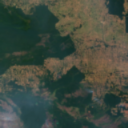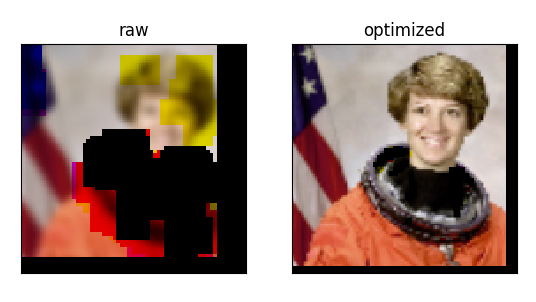The delayed_image module
Project description
The delayed image module lets you describe (a tree of) image operations, but waits to execute them until the user calls finalize. This allows for a sequence of operations to be optimized before it is executed, which means faster execution and fewer quantization artifacts.
The optimization logic can also leverage image formats that contain builtin tiling or overviews using the GDAL library. Formats that contain tiles allow delayed image to read only a subset of the image, if only a small part is cropped to it. Overviews allow delayed image to load pre-downscaled images if it detects a scaling operation. This is much faster than the naive way of accomplishing these operations, and much easier than having to remember to do everything in the right order yourself.
Note: GDAL is optional, but recommended. Precompiled GDAL wheels are available on Kitware’s large image wheel repository. Use pip install gdal -f https://girder.github.io/large_image_wheels/ to install gdal from this server. Track status of official gdal wheels here.
History
This module is still in its early days of development and is a port the following code from kwcoco:
ChannelSpec
SensorChannelSpec
DelayedLoad & other delayed operations
Quick Start
# Given a path to some image
import kwimage
fpath = kwimage.grab_test_image_fpath('amazon')
# Demo how to load, scale, and crop a part of an image.
import delayed_image
delayed = delayed_image.DelayedLoad(fpath)
delayed = delayed.prepare()
delayed = delayed.scale(0.1)
delayed = delayed[128:256, 128:256]
import kwplot
kwplot.autompl()
kwplot.imshow(delayed.finalize())
kwimage.imwrite('foo.png', delayed.finalize())
See the quickstart jupyter notebook for more details.
Delayed Loading
Example of delayed loading:
>>> from delayed_image import DelayedLoad
>>> import kwimage
>>> fpath = kwimage.grab_test_image_fpath(overviews=3)
>>> dimg = DelayedLoad(fpath, channels='r|g|b').prepare()
>>> quantization = {'quant_max': 255, 'nodata': 0}
>>> #
>>> # Make a complex chain of operations
>>> dimg = dimg.dequantize(quantization)
>>> dimg = dimg.warp({'scale': 1.1})
>>> dimg = dimg.warp({'scale': 1.1})
>>> dimg = dimg[0:400, 1:400]
>>> dimg = dimg.warp({'scale': 0.5})
>>> dimg = dimg[0:800, 1:800]
>>> dimg = dimg.warp({'scale': 0.5})
>>> dimg = dimg[0:800, 1:800]
>>> dimg = dimg.warp({'scale': 0.5})
>>> dimg = dimg.warp({'scale': 1.1})
>>> dimg = dimg.warp({'scale': 1.1})
>>> dimg = dimg.warp({'scale': 2.1})
>>> dimg = dimg[0:200, 1:200]
>>> dimg = dimg[1:200, 2:200]
>>> dimg.write_network_text()
╙── Crop dsize=(128,130),space_slice=(slice(1,131,None),slice(2,130,None))
└─╼ Crop dsize=(130,131),space_slice=(slice(0,131,None),slice(1,131,None))
└─╼ Warp dsize=(131,131),transform={scale=2.1000}
└─╼ Warp dsize=(62,62),transform={scale=1.1000}
└─╼ Warp dsize=(56,56),transform={scale=1.1000}
└─╼ Warp dsize=(50,50),transform={scale=0.5000}
└─╼ Crop dsize=(99,100),space_slice=(slice(0,100,None),slice(1,100,None))
└─╼ Warp dsize=(100,100),transform={scale=0.5000}
└─╼ Crop dsize=(199,200),space_slice=(slice(0,200,None),slice(1,200,None))
└─╼ Warp dsize=(200,200),transform={scale=0.5000}
└─╼ Crop dsize=(399,400),space_slice=(slice(0,400,None),slice(1,400,None))
└─╼ Warp dsize=(621,621),transform={scale=1.1000}
└─╼ Warp dsize=(564,564),transform={scale=1.1000}
└─╼ Dequantize dsize=(512,512),quantization={quant_max=255,nodata=0}
└─╼ Load channels=r|g|b,dsize=(512,512),num_overviews=3,fname=astro_overviews=3.tif
>>> # Optimize the chain
>>> dopt = dimg.optimize()
>>> dopt.write_network_text()
╙── Warp dsize=(128,130),transform={offset=(-0.6...,-1.0...),scale=1.5373}
└─╼ Dequantize dsize=(80,83),quantization={quant_max=255,nodata=0}
└─╼ Crop dsize=(80,83),space_slice=(slice(0,83,None),slice(3,83,None))
└─╼ Overview dsize=(128,128),overview=2
└─╼ Load channels=r|g|b,dsize=(512,512),num_overviews=3,fname=astro_overviews=3.tif
#
>>> final0 = dimg.finalize(optimize=False)
>>> final1 = dopt.finalize()
>>> assert final0.shape == final1.shape
>>> # xdoctest: +REQUIRES(--show)
>>> import kwplot
>>> kwplot.autompl()
>>> kwplot.imshow(final0, pnum=(1, 2, 1), fnum=1, title='raw')
>>> kwplot.imshow(final1, pnum=(1, 2, 2), fnum=1, title='optimized')
SensorChanSpec
Includes the SensorChan spec, which makes handling channels from different sensing sources easier.
It has a simple grammar:
// SENSOR_CHAN_GRAMMAR ?start: stream // An identifier can contain spaces IDEN: ("_"|"*"|LETTER) ("_"|" "|"-"|"*"|LETTER|DIGIT)* chan_single : IDEN chan_getitem : IDEN "." INT chan_getslice_0b : IDEN ":" INT chan_getslice_ab : (IDEN "." INT ":" INT) | (IDEN ":" INT ":" INT) // A channel code can just be an ID, or it can have a getitem // style syntax with a scalar or slice as an argument chan_code : chan_single | chan_getslice_0b | chan_getslice_ab | chan_getitem // Fused channels are an ordered sequence of channel codes (without sensors) fused : chan_code ("|" chan_code)* // A channel only part can be a fused channel or a sequence channel_rhs : fused | fused_seq // Channels can be specified in a sequence but must contain parens fused_seq : "(" fused ("," fused)* ")" // Sensors can be specified in a sequence but must contain parens sensor_seq : "(" IDEN ("," IDEN)* "):" sensor_lhs : (IDEN ":") | (sensor_seq) sensor_chan : sensor_lhs channel_rhs? nosensor_chan : channel_rhs stream_item : sensor_chan | nosensor_chan // A stream is an unordered sequence of fused channels, that can // optionally contain sensor specifications. stream : stream_item ("," stream_item)* %import common.DIGIT %import common.LETTER %import common.INT
You can think of a channel spec is that splitting the spec by “,” gives groups of channels that should be processed together and “late-fused”. Within each group the “|” operator “early-fuses” the channels.
For instance, say we had a network and we wanted to process 3-channel rgb images in one stream and 1-channel infrared images in a second stream and then fuse them together. The channel specification for channels labled as ‘red’, ‘green’, ‘blue’, and ‘infrared’ would be:
infrared,red|green|blueSensors can be included with a colon prefix. Parenthesis can be used for grouping.
S2:(infrared,red|green|blue)Project details
Release history Release notifications | RSS feed
Download files
Download the file for your platform. If you're not sure which to choose, learn more about installing packages.
Source Distributions
Built Distribution
Hashes for delayed_image-0.2.4-py3-none-any.whl
| Algorithm | Hash digest | |
|---|---|---|
| SHA256 | b2885862c86ebcf5e692e0e3d9a13c1cef9d7c2a4f03add00aa0cc5a68ada5c6 |
|
| MD5 | 352b2fe8fd67af23aaa79ad552257b93 |
|
| BLAKE2b-256 | 67bf91663b04f9dd28f9789169b3c36182ed6f76561ffdc7b389e79e048e9916 |















